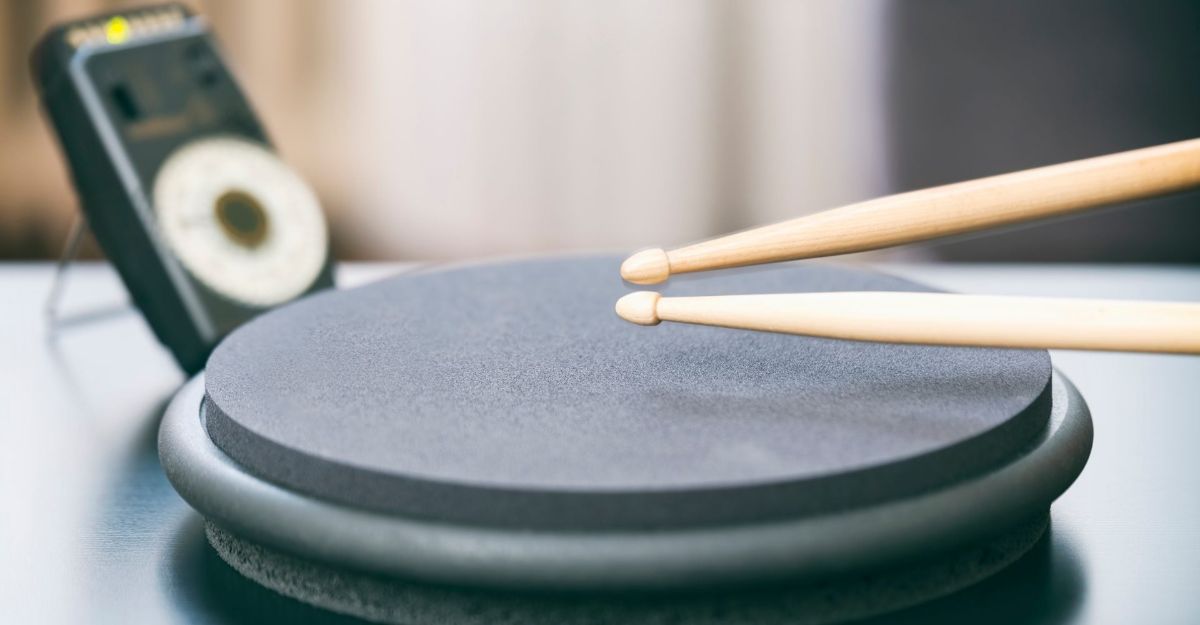As a drummer, timing is everything. Whether you’re jamming with musicians or recording in a studio, maintaining a steady tempo is vital for creating a polished and cohesive drum sound.
To achieve this level of precision and accuracy whilst performing, drummers are required to practice to a click track.
In this blog post, we’ll dive deep into the world of click tracks, exploring their purpose, benefits, and impact on drumming performances.
Whether you’re a drummer looking to elevate your skills or simply curious about the inner workings of musical synchronization, this article will shed light on the significance of the click track in the drumming world.
Contents
What is a Click Track for Drums?
A click track is a metronome that helps any musician stay in time to a set tempo. It comes in a few variations, and as a drummer, you will most likely either play to one in the studio or play along to one via a mobile app or piece of gear it’s integrated into at a live show.
Click tracks help drummers maintain consistent timing during performances or recordings. It provides a steady beat or pulse that the drummer can follow to ensure precise timing and synchronization with other musicians or tracks.
Drummers listen to a click track through the use of drumming headphones, or more commonly, in ear monitors.
Why is Playing Drums to a Click Track Important?
There are many debates and different personal preferences surrounding the use of click tracks, but playing drums to a click track is crucial for many reasons.
Enhanced Recording Accuracy
When it comes to recording, click tracks act as a reference point, helping maintain a consistent tempo throughout the recording process. This accuracy is crucial for creating polished recordings and facilitates easier editing and mixing.
A click track in a recording studio serves as a crucial guide, and makes you and the recording engineer aware of how close and ‘on the beat’ you are with your performances. By listening back to your recordings with a click track you can also see room for improvement by identifying any tempo fluctuations.
Improving Your Sense of Timekeeping
Playing drums to a click track is integral for developing a strong sense of timing and rhythm. Practicing to a click will ensure that you as a drummer can maintain a consistent tempo and stays in sync with other musicians. This precision is crucial for creating a tight and cohesive musical performance.
Through dedicated drumming practice, you will learn to play to a click more accurately both in the recording studio and live, and crucially, you will also be a tighter player without a click. This is because naturally your internal timekeeping will improve overtime, which is a sign you are becoming a better drummer.
Introducing a click track for drums into band practice sessions can be a game-changer too. As a drummer, you are the rhythmic backbone of the band and once you can play accurately to a click, your whole band’s timing will improve and you will sound much tighter.
At a live show, it can be easy to tell which bands do and don’t play to a click; playing to one will make you sound much more professional to both the trained and untrained ear.
Modern Music Demands Tighter Live Performances
Modern music also demands more detailed live performances, with backing tracks being played from workstations such as Ableton and Logic from a laptop through the PA whilst the drummer keeps the band in time to the pre recorded tracks via a click track.
Playing along to backing tracks and click tracks live is a very important aspect of contemporary live music performances within pop music, R&B, metal, hip hop, and many more styles.
The studio is where your timing will really get put to the test; if you can’t drum to a click (which you may well have to) then you’re going to have a nightmare. It’s okay saying to the engineer you want to record live as a band for the feel (oldie) but 99% of your potential audience won’t be listening to your record for the feel. They want it to sound awesome and so do you.
To compete with the big guns, you need tight-sounding music, which all starts with you playing to a click track for drums. Failure to prepare for the studio by learning to play to a click will result in a very frustrated engineer, a deflated you, wasted studio time, and perhaps the worst of all – a sub-par final product; whether that’s your band’s music or a session recording.
Note: Playing well in time to a click track will not take away from the feel or naturalness of the drums. Playing poorly so you have to get your drums automatically quantized to the beat will be much more likely to do that.
How to Play Drums With a Click Track
Tip 1: Practice to a Click Track on a Practice Pad
You may wonder how some drummers at the very top of their game manage to play very technically at a high tempo whilst sounding very clean. The key to this is to slow the tempo of the click right down, sometimes by more than half, and practice your fills slowly to that click over and over. Once everything is perfect and you can play a fill note for note over and over again, increase the tempo slightly and repeat the process.
If you play at full speed all the time, you don’t notice all the little errors in your playing. Maybe you add in an extra note when you shouldn’t, or maybe you miss one out. Either way, slowing it right down and playing to a click will help you perfect your playing at a slow speed. If you can’t play your parts well slowly, you sure for shit can’t play them well at full speed.
So, learn a rhythm or a snare roll and play it at half speed until it is perfect in terms of how clean the hits are, the velocity consistency and the timing. Then Increase by 10% at a time until you reach the actual tempo of the performance. To take it a step further, you can learn it at 110% and 120% to make playing at normal speed seem even easier.
Practicing on a quality practice pad enables you to purely focus on hitting in time with the click and not worry about what drum/cymbal to hit and when. Once you get comfortable with this you can then take it onto the kit.
Tip 2: Play to a Backing Track with a Click
Playing to a backing track with a click in your in ear monitors is perhaps the simplest way to improve your playing. It’s important when doing this to focus on the click and not the instruments.
In theory, the instruments in the backing track should be in time to the click, however, as a drummer the click should always be your time-keeping reference.
The bonus of this method is it’s fun as hell. What could be a better way of learning to play in time to a click than to jam along with some of your favorite songs? Find some backing tracks for your favorite tunes and play to them over and over again. I’m sure you’d rather do this than just play your drums aimlessly over a metronome for hours on end.
You can do this a couple of different ways. You could download a drum backing track off the internet (which there are loads of) which usually includes a click and play along to it in some headphones. Alternatively, if you have a DAW, load a backing track in there and use the DAW’s click/metronome.
Tip 3: Record Yourself Playing to a Click Track
If you have any recording gear, you need to make the absolute most of it. Take a step further than the previous tip and actually record yourself playing to a click track. The number of drummers I know who will record a take in the studio and think it was amazing, then listen back and be horrifically surprised is unreal!
Likewise, it’s going to be so easy for you to play to a backing track with a click and think you’re nailing it. In reality, without the audible feedback from a recording, you can’t assume you’re getting it right. I would personally record your first attempt, practice for 30 minutes, and record again. Repeat this process until you’re happy you can’t physically do any better.
You can then compare your performances and you should be able to hear a noticeable amount of improvement in your timing.
Listening to these improvements will motivate you to keep going and make you feel accomplished in your efforts. Without this, you’re going to get frustrated with very quickly.

Tip 4: Play to Just a Click Track
Once you’re nailing the previous tips, this is a good way to dial in your timing accuracy.
No matter how much I tell you to ignore other instruments and focus on the click, it’s not going to be easy and you’re always going to be distracted to some extent.
Choose a song you know well note for note and section by section, without any need for a backing track. Set up the song’s tempo with a click track and have it in your drumming headphones. Then play this song purely just to the click, distraction-free.
Really focus on your timing whilst playing to just a click track for drums, ensure that your quarter-note cymbal/hat hits lock in with each click, and your snare land nicely on beats 2 and 4 if playing a backbeat section (or beat 3 for half time). You want to come round perfectly to that first beat at the end of every bar which usually has a kick on.
Note that this is exactly how you will be tracking in the studio unless there are guide tracks that are purely to let you know where you are in the section/song and will be very rough. So once you get the hang of this you will be equipped with this valuable skill and find recording much easier.
Final Thoughts
In summary, a click track is important for drummers because it will improve your playing accuracy in the recording studio, help you develop a strong sense of timing, and enable you to maintaining a steady tempo while playing with a band without tempo fluctuations.
Regular practice with a click track can greatly enhance a drummer’s precision and overall performance abilities.
The sooner you start playing with a click track for drums, the sooner you will improve, so don’t delay it any longer if you have been procrastinating doing this before.
Mastering playing to a click for drums isn’t easy, but you have taken the first step by educating yourself with this article. I believe in you that you can take this information and apply it to your drumming.
What are you waiting for!









